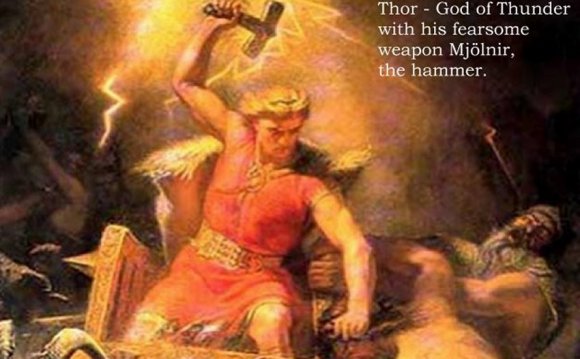
BBY193 Thor son of Woden or Odin the second god in the ancient Scandinavian pantheon riding in chariot drawn by goats and wielding his
The Norse thunder god, Thor, wields his hammer, Mjöllnir, in an undated woodcut. Illustration from World History Archive, Alamy.
Long dismissed as accidental additions to Viking graves, prehistoric "thunderstones"—fist-size stone tools resembling the Norse god Thor's hammerhead—were actually purposely placed as good-luck talismans, archaeologists say.
Using fire-starting rock such as flint, Stone Age people originally created the stones to serve as axes. But the Vikings, whose Iron Age heyday lasted from about A.D. 800 to 1050, saw the primitive tools as lightning repellent.
Because the axes predate the Viking age by thousands of years, archaeologists have long seen the stones as random artifacts, perhaps stirred up from earlier, lower burials or dropped in centuries after the Viking era.
To solve the thunderstone mystery, Thäte and fellow archaeologist Olle Hemdorff excavated Viking graves in Scandinavia and trawled through catalogs of grave goods from hundreds of Viking burials—all dating to the Iron Age (about 600 A.D. to 1000 A.D.).
For example, in Scandinavia the researchers found about ten Viking burials that held thunderstones up to 5, 000 years older than the graves themselves—including a thunderstone in a previously untouched, fifth-century A.D. stone coffin.
"These people must have gone to all the effort of bringing these goods over from Norway, on an exceedingly dangerous boat journey, " Hemdorff, of the University of Stavanger in Norway, told National Geographic News.
"There is no rational explanation as to why they should appear in the graves—the pebbles were far too small to be useful in any way, " Hemdorff said. "It shows that these stones had very special significance and suggests that these people were highly superstitious."
The prehistoric stones' "special significance" to Vikings may have derived from legends of Thor, the Norse thunder god said to create lightning with his battle hammer, Mjöllnir.
To the Vikings, "three things seem to be important when choosing thunderstones, " Hemdorff said.
"The form had to be similar to an ax or a hammer—that is, a ground stone or flint. The stone had to have 'flaming' properties, which flint and quartz have. And all the stones were damaged with the edge chipped off—'proof' that they fell from the sky, " he added.
"Thor's mission was to protect gods and people against evil and chaos, " he said in a statement. "It was therefore believed that Thor's rocks protected houses and people."
Now the new grave survey suggests the rocks were believed to protect souls too, the archaeologists say.
"In southeast Britain the Lexden Tumulus—a wealthy late Iron Age burial dating to just before the Roman conquest—included within it not only rich contemporary imports from the classical world but also a Bronze [ax] dating to the Bronze age, " said John Creighton, an Iron Age expert from the University of Reading in the U.K.
When such out-of-date artifacts are found randomly at archaeological sites, "it is easy to explain them away as residual objects, " Creighton said. But when they're found "sealed in graves, as they occasionally are, they are clearly treasured objects."
In southern England grinding stones and Stone Age stone axes have been found in Iron Age ritual pits that aren't associated with burial but instead may have been used, for example, to mark the end of an occupation of a site, said Champion, of the University of Southampton in the U.K.
"They are a real oddity and were certainly placed there deliberately, but we're not sure why, " he said. "I suspect that these people were not so very different from us, and they would have had superstitious folk beliefs."









